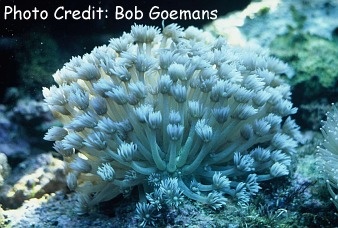
By Bob Goemans

Likely Reef Tank Suitable
Likely Fish-Only Tank Suitable
Range: Indo-West Pacific Ocean: Widespread.
Natural Environment: This normally free-living photosynthetic stony coral is usually found in protected lagoons having turbid water conditions. It is also found on patch reefs, reef flats, lagoon backwaters, muddy bottoms and coral rubble areas where sediment collects and/or have high plankton counts that cloud the water and generally seen at depths between 6 to 100 feet (2 - 30 m).
General Husbandry: Common in the trade.
Usually develops a highly porous half-rounded skeleton, sometimes with short thick columns, and has long tube/stem-like polyps that lends realism to its "Flowerpot" common name. Length of the polyps can exceed 12 inches (30 cm). Polyps are extended during day and somewhat retracted at night.
Imported specimens are usually available in green or brown colors, and occasionally pink or yellow.
Placement in the aquarium is best in lightly shaded areas having slow moving water current and should not be on rocks or ledges where the specimen can fall and be injured. The aquarium bottom is the safest placement area.
Care should also be taken as to its position in the aquarium, as this species is basically defenseless against other corals, even those that are not overly aggressive.
Even though its thought capable of producing all its nutritional needs via photosynthesis, liquid nutrients foodstuffs fed via a syringe occasionally may be beneficial/promote quicker growth.
Taxonomy:
Kingdom: Animalia
Phylum: Cnidaria
Class: Anthozoa
Subclass: Hexacorallia
Order: Scleractinia
Family: Poritidae
Genus: Goniopora
FYI: In the wild, small mound shaped growths with long polyps that are usually pale brown or green, usually with green tentacles.
Even though these corals are often available and quite attractive, besides being reasonably priced, without additional feeding specifically tuned to their needs, long-term survivorship is still chancy.
Recommend anemonefishes not be kept in the same tank, as they may tend to use its long stemmed polyps as they would an anemone and that would stress the coral. This undue stress would soon cause the polyps to cease extending, with its demise soon following.
Iron and manganese supplements, suggested by Julian Sprung, may be helpful in lengthening lifespan in aquaria.
Goniopora is sometimes misidentified as Alveopora. Goniopora have 24 tentacle tips, whereas Alveopora has 12 tentacle tips.
Do not remove a specimen with extended polyps from the water as the weight of the water in the polyps may damage or tear its flesh. Gently shake the specimen and allow the polyps to mostly retract before removing.
Experience Level: Intermediate
Diet: Photosynthetic/Absorb dissolved organic matter
Temperament: Peaceful
Aquarium Environment: Reef or fish-only aquarium
Coral Safe: With caution
Fish Safe: Yes
Invertebrate Safe: Yes
Acclimation Time: 30 minutes+
Aquarium Hardiness: Moderately difficult
Calcium (Ca): 380 - 430 mg/l
Alkalinity: 2.5 - 3.0 meq/l
Phosphate (PO4): <0.05 mg/l
Magnesium (Mg): approx. 1350 mg/l (relate to specific gravity)
Strontium (Sr) 8 - 10 mg/l
Temperature Range: 77 - 83°F (25 - 28°C)
Minimum Tank Size: 30 gallons
Lighting: PAR 200 - 300+
Water Movement: WM 1
Specific Gravity: 1.023 - 1.025
pH: 8.0 - 8.4
Iodine/Trace Elements Monitor/as necessary to maintain quality seawater.
